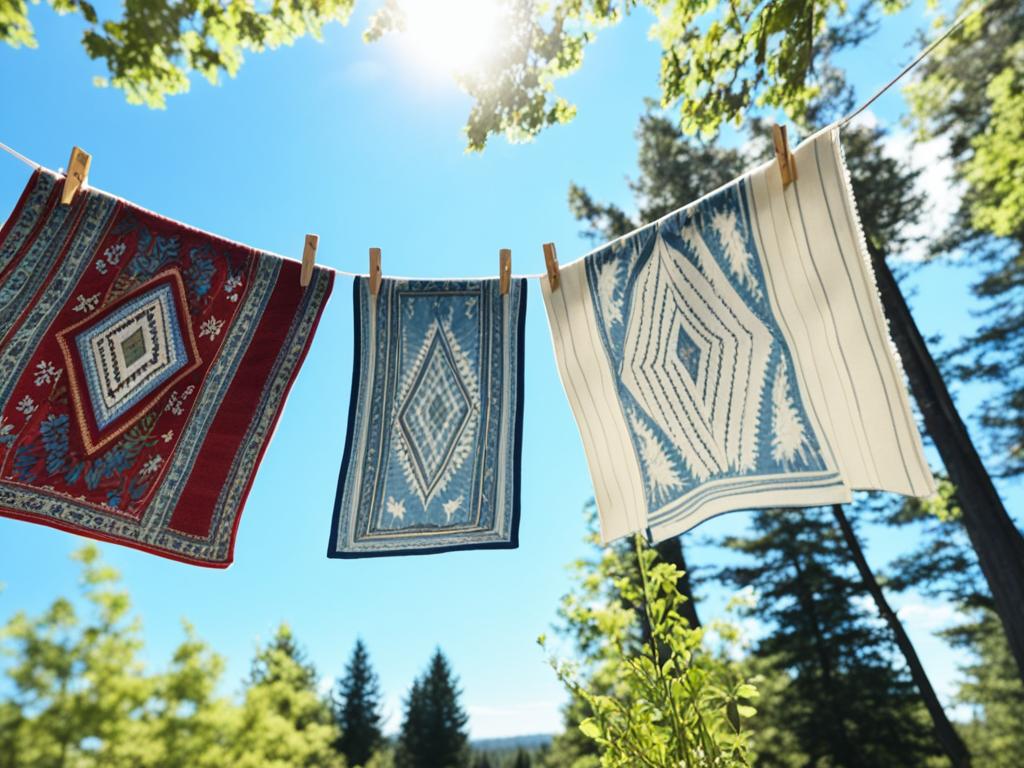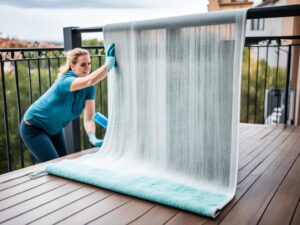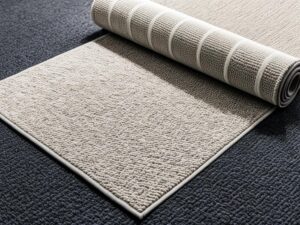Properly drying a rug after pressure washing is crucial for maintaining its quality and preventing mold growth. After all the effort put into pressure washing, the last thing you want is for your rug to become a breeding ground for mold and mildew. In this article, we will explore expert tips and techniques to effectively dry a rug and speed up the drying process, while ensuring the rug remains in good condition.
Whether you are a professional rug cleaner or simply a homeowner eager to tackle the task yourself, this guide will provide you with the knowledge and confidence to dry your rug effectively. Say goodbye to soggy carpets and hello to a fresh and dry rug!
Key Takeaways:
- Learn how to dry a rug after pressure washing
- Discover the best techniques for drying a pressure washed rug
- Speed up the rug drying process with expert tips and tricks
- Prevent mold growth after pressure washing your rug
- Explore professional rug drying methods for optimal results
Preparing the Rug for Drying
After pressure washing your rug, it is essential to take the necessary steps to remove excess water and prepare it for drying. This will not only expedite the drying process but also help avoid potential damage to the rug fibers. Follow these simple guidelines to ensure your rug dries efficiently and safely.
Evaluating the Water Content
Start by assessing the water content in your rug. Gently press the rug with your hands to determine the amount of water it has absorbed. If the rug feels excessively wet, it is crucial to remove as much water as possible before proceeding with the drying process.
Using a rubber squeegee or similar implement, gently glide it across the rug’s surface to remove the excess water. Be careful not to apply too much pressure, as this could damage the fibers. Instead, focus on light, sweeping motions to minimize the risk of causing harm.
Gently Pressing the Rug to Absorb Water
Once you have removed the majority of excess water, it is time to further facilitate drying by absorbing the remaining moisture. Lay out a clean, absorbent towel on a flat surface and place the rug on top. Gently press down on the rug, allowing the towel to absorb the water. Repeat this process, repositioning the rug on the towel as needed, until minimal water transfer occurs.
Remember to avoid scrubbing or vigorously pressing the rug, as this can lead to fiber distortion and damage. The goal is to draw out the moisture gradually, ensuring the rug dries evenly and maintains its original shape.
Avoiding Damage When Drying a Rug
To prevent any potential damage, it is crucial to follow proper drying practices. Avoid hanging a wet rug on a clothesline or wire, as this can cause stretching and distortion. Instead, lay the rug flat on a clean surface, preferably in a well-ventilated area.
If you need to speed up the drying process, using fans or dehumidifiers strategically can help. Position the fans or dehumidifiers near the rug, ensuring proper air circulation without directly blowing air onto the rug’s surface.
Remember, patience is key when drying a rug. Rushing the process by exposing the rug to excessive heat or vigorous air movement can result in irreversible damage. Allow the rug to dry naturally at its own pace, and monitor the progress until it is completely dry.
By following these steps and taking careful measures to remove excess water and avoid damaging the rug fibers, you can effectively prepare your pressure-washed rug for drying.
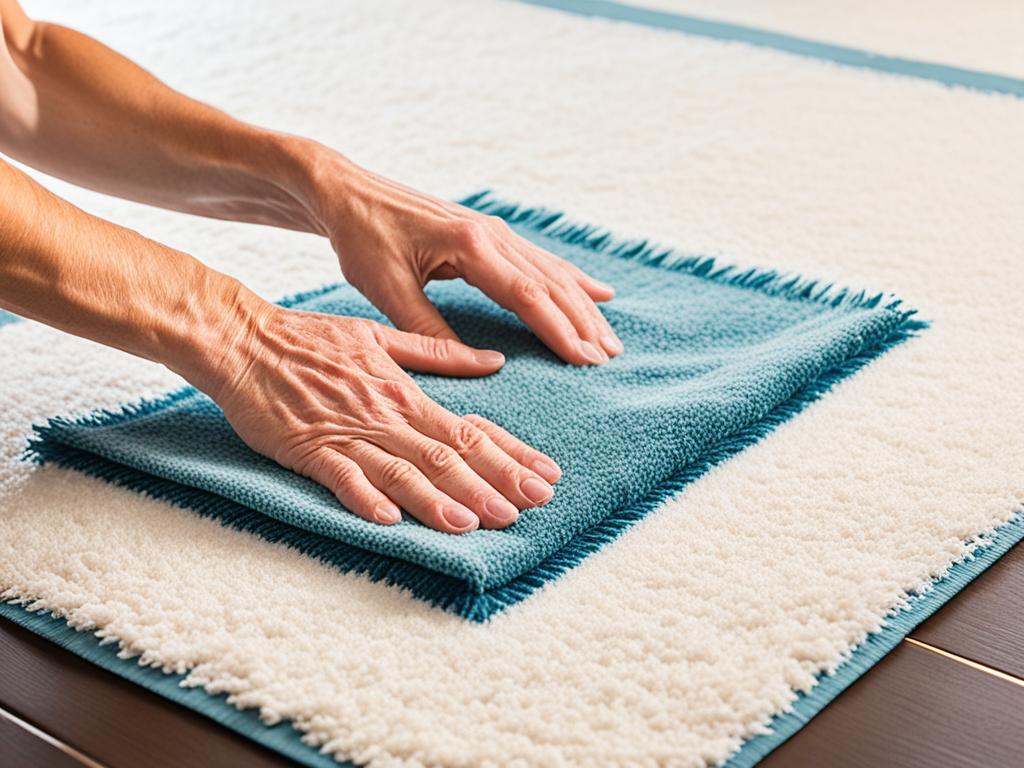
The Drying Process
Once the excess water has been removed manually, the next step is to allow the rug to dry naturally. In this section, we will discuss three effective methods for drying a rug:
Hanging a Rug for Drying
Hanging a rug is a traditional method that promotes gravity-based drying. Find a suitable location, preferably outdoors or in a well-ventilated area, and hang the rug vertically using a sturdy clothesline or a drying rack. Make sure the rug is evenly supported to prevent deformation. This method allows air to circulate freely, expediting the drying process.
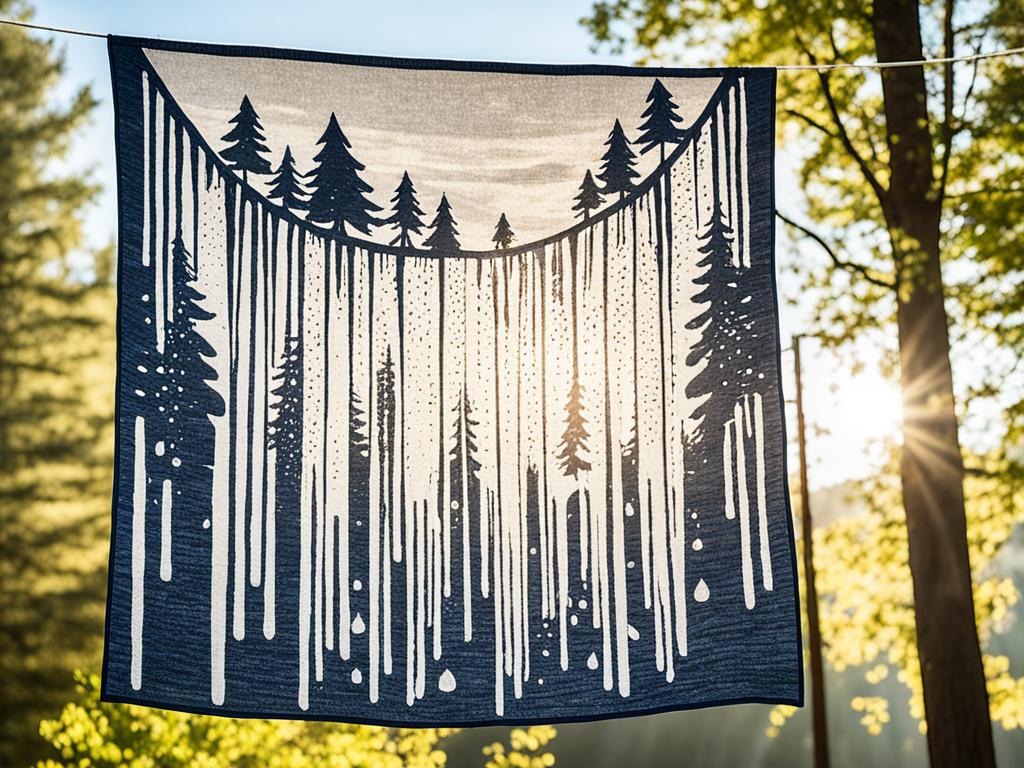
Using Dry Towels to Dry a Rug
Incorporating dry towels into the drying process can help absorb excess moisture from the rug. Lay the rug on a clean, dry surface and place absorbent towels on top. Gently press the towels against the rug, focusing on areas that are particularly damp. As the towels become saturated, replace them with dry ones. Repeat this process until the rug is adequately dry.
Using Fans and Dehumidifiers to Dry a Rug
Utilizing fans and dehumidifiers can significantly speed up the evaporation process and facilitate faster rug drying. Place fans strategically around the rug to circulate air and promote airflow. Additionally, set up a dehumidifier in the room to reduce humidity levels and aid in moisture removal. Ensure the rug is positioned in a well-ventilated area for optimal results.
By employing these effective rug drying methods, you can shorten the drying time and prevent potential mold or mildew growth. Remember to take precautions during the drying process to maintain the rug’s quality and integrity.
Post-drying Steps
Once your rug is completely dry, it’s important to take a few additional steps to ensure it returns to its original state. These post-drying steps will help maintain the texture and appearance of your dry rug, as well as remove any detergent residue that may be left behind. Additionally, professional cleaning can provide a thorough maintenance solution for your dry rug.
Inspecting the Dry Rug
Before proceeding with any further maintenance, it’s crucial to inspect your dry rug to ensure it is completely dry. Run your hands over the surface and check for any dampness or moisture. This step is important to prevent mold growth or unpleasant odors from developing in the rug.
Vacuuming to Restore Texture
Vacuuming is an essential step in maintaining the texture and appearance of your dry rug. Use a vacuum cleaner with a brush attachment and gently run it over the surface of the rug. This will help remove any dirt or debris that may have accumulated during the drying process, restoring the rug’s softness and plushness.
Removing Detergent Residue
While pressure washing and drying the rug, it’s possible that some detergent residue may remain on the fibers. To remove this residue, mix a solution of mild detergent in warm water. Dampen a clean cloth or sponge with the solution and gently blot the affected areas. Avoid scrubbing vigorously, as it may damage the rug’s fibers. Rinse with clean water and allow the rug to air dry.
Professional Cleaning for Thorough Maintenance
For a comprehensive and thorough maintenance solution, consider professional cleaning for your dry rug. Professional cleaners have the expertise and equipment to deep clean and rejuvenate your rug, removing deep-seated dirt, stains, and odors. They can also provide specialized treatments to protect the rug’s fibers and prolong its lifespan.
By following these post-drying steps, you can ensure that your dry rug remains in optimal condition, with its texture, appearance, and cleanliness preserved. Regular vacuuming, periodic removal of detergent residue, and professional cleaning will help extend the life of your rug, allowing you to enjoy its beauty and functionality for years to come.
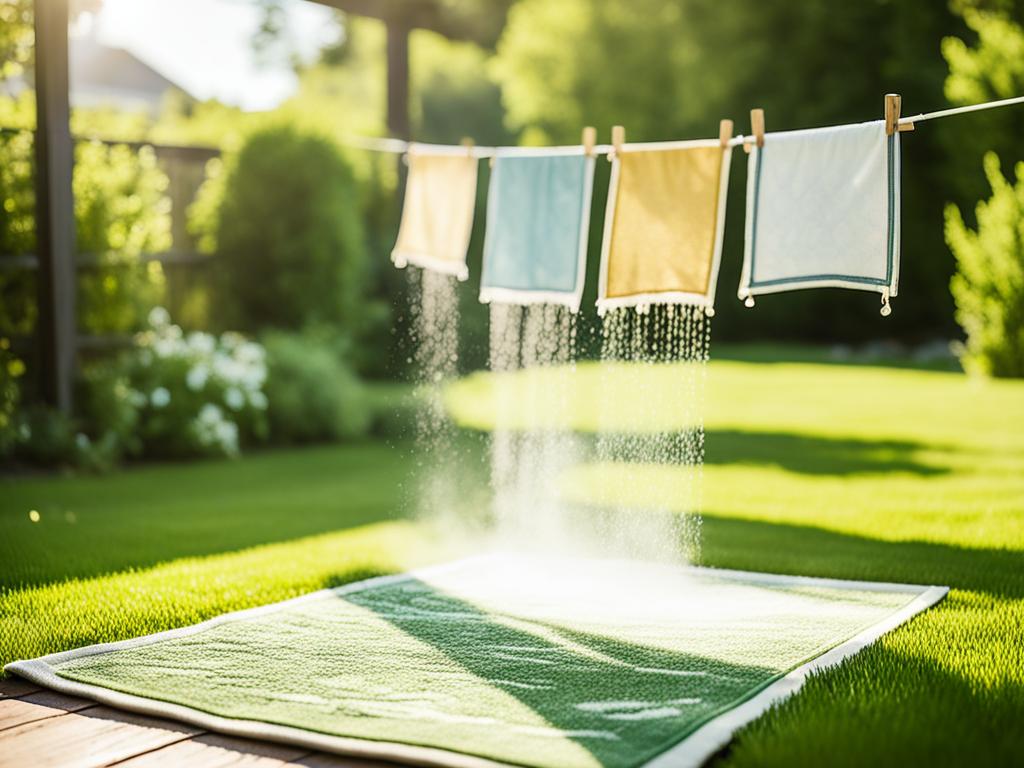
Pros and Cons of Rug Drying Methods
Each rug drying method has its advantages and limitations. In this section, we will explore the pros and cons of the three methods mentioned earlier: outdoor drying, towel drying, and using fans and dehumidifiers. By understanding the benefits and drawbacks of each method, readers can make an informed decision on the best approach for their specific situation.
Outdoor Rug Drying
Outdoor rug drying is a popular method for quickly drying rugs. Here are the pros and cons:
| Pros | Cons |
|---|---|
| Allows for natural airflow, promoting faster drying | Weather-dependent – not suitable during rainy or humid conditions |
| Exposure to sunlight helps kill bacteria and eliminate odors | Prolonged exposure to direct sunlight may cause color fading |
| Minimal effort required – simply hang the rug and let nature do the work | Potential risk of dust or dirt settling on the rug |
Towel Drying a Rug
Towel drying is a manual method that can be effective for smaller rugs. Here are the pros and cons:
| Pros | Cons |
|---|---|
| Allows for precise control of moisture absorption | Time-consuming, especially for larger rugs |
| Gentle on the rug fibers, minimizing the risk of damage | Requires multiple towels and frequent rotation to ensure thorough drying |
| No additional equipment required | May not be suitable for thicker rugs that retain more water |
Using Fans and Dehumidifiers
Utilizing fans and dehumidifiers is a proactive approach to speed up the drying process. Here are the pros and cons:
| Pros | Cons |
|---|---|
| Increases airflow and accelerates evaporation | Requires access to electricity and additional equipment |
| Reduces the risk of mold or mildew growth | Can be noisy, depending on the fan or dehumidifier |
| Effective for thicker rugs or in high humidity environments | Higher energy consumption |
By considering the pros and cons of outdoor rug drying, towel drying, and using fans and dehumidifiers, you can choose the method that aligns best with your drying needs and preferences. Whether you prioritize speed, convenience, or preserving the rug’s quality, there is a drying method that will suit your requirements.
Alternative Methods to Clean Rugs Effectively
While pressure washing is a popular method for cleaning rugs, it may not be suitable for all types of rugs. Fortunately, there are alternative cleaning methods that can effectively remove dirt and stains from your rugs. Let’s explore these methods in detail:
Vacuuming a Rug
Vacuuming your rug regularly is an essential step in maintaining its cleanliness. By removing surface dirt and debris, you can prevent them from embedding deep into the fibers and causing long-term damage. When vacuuming, make sure to use a vacuum cleaner with appropriate settings for your rug’s material and pile height. Additionally, consider using vacuum attachments for gently cleaning delicate areas.
Spot Cleaning a Rug
Accidents happen, and when a spill or stain occurs on your rug, spot cleaning is a quick and effective solution. Start by blotting the affected area with a clean cloth or paper towel to absorb as much liquid as possible. Then, prepare a mild cleaning solution using water and a gentle rug cleaner. Apply the solution to the stain using a clean cloth or soft brush, and gently blot until the stain is lifted. Rinse the area with water and blot dry.
Tip: Test any cleaning solution on a small, inconspicuous area of the rug before applying it to the stain to ensure it does not cause discoloration or damage.
Professional Cleaning for Delicate Rugs
For delicate or heavily soiled rugs, professional cleaning is often the best option. Professional rug cleaners have the expertise and specialized equipment to handle various rug materials and designs safely. They can deep clean your rug, removing embedded dirt and stains while preserving its integrity. When considering professional cleaning, choose a reputable service provider with experience in handling rugs similar to yours.
| Method | Benefits | When to Use |
|---|---|---|
| Vacuuming | Removes surface dirt, prevents deep embedding | Regular maintenance, surface cleaning |
| Spot Cleaning | Quickly removes specific stains or spills | Immediate response to accidents |
| Professional Cleaning | Deep cleans delicate or heavily soiled rugs | Delicate rugs, extensive dirt or stains |
By utilizing these alternative methods for cleaning rugs, you can ensure the cleanliness and longevity of your prized possessions. Whether you opt for regular vacuuming, spot cleaning for minor issues, or professional cleaning for delicate rugs, there’s a solution for every rug cleaning need.
Conclusion
Properly drying a rug after pressure washing is crucial for maintaining its quality and preventing mold growth. By following the expert tips and techniques outlined in this article, you can effectively dry your rugs and ensure they remain in good condition.
Whether you choose to use traditional drying methods such as hanging the rug or utilizing alternative approaches like towel drying or fans and dehumidifiers, it’s essential to consider the material and condition of the rug for the best results.
Remember, the key to maintaining rug quality after pressure washing is to remove as much excess water as possible, allow the rug to dry naturally, and take post-drying steps such as inspecting and vacuuming to restore its texture. In certain cases, professional cleaning may also be necessary to ensure a thorough cleanse.
By implementing these effective rug drying techniques, you can enjoy clean, fresh rugs without worrying about damage or mold growth. Take care of your rugs, and they will continue to add beauty and comfort to your home for years to come.
